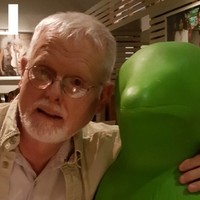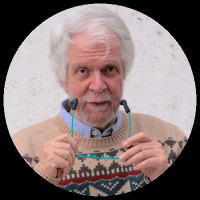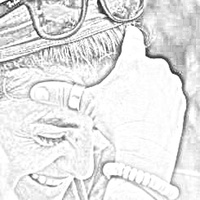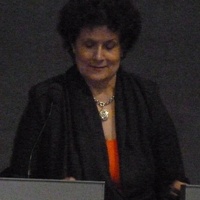Papers by Karen McGarry

Elliot Eisner: Proponent of Surprise (1933–2014)
The Palgrave Handbook of Educational Thinkers, 2022
Elliot Eisner was a painter and an educator who thought across and through disciplines of art and... more Elliot Eisner was a painter and an educator who thought across and through disciplines of art and education. As an educational thinker, Eisner learned from theorists who would ultimately guide his intellect and foster his appreciation for how the arts impacted learning. His own connoisseurship, sense of critique, and belief in experiential learning produced expressive outcomes in the students he nurtured, who would later carry on his legacy. The attention he paid to curriculum led him toward crafting a program of study that embraced artful practices for teachers unskilled in the arts. The intent, he wrote, was to help teachers inform their students of how the arts might enrich and inform lived experiences. In his thinking, the arts possessed a unique interpretability revealed in the process of artmaking. His contention held that artistic methods enveloped the potential to awaken pluralistic approaches to teaching and learning, stretching the boundaries

The Palgrave Handbook of Educational Thinkers, 2022
Elliot Eisner was a painter and an educator who thought across and through disciplines of art and... more Elliot Eisner was a painter and an educator who thought across and through disciplines of art and education. As an educational thinker, Eisner learned from theorists who would ultimately guide his intellect and foster his appreciation for how the arts impacted learning. His own connoisseurship, sense of critique, and belief in experiential learning produced expressive outcomes in the students he nurtured, who would later carry on his legacy. The attention he paid to curriculum led him toward crafting a program of study that embraced artful practices for teachers unskilled in the arts. The intent, he wrote, was to help teachers inform their students of how the arts might enrich and inform lived experiences. In his thinking, the arts possessed a unique interpretability revealed in the process of artmaking. His contention held that artistic methods enveloped the potential to awaken pluralistic approaches to teaching and learning, stretching the boundaries

Art/Research International: A Transdisciplinary Journal
Literacy is more directly linked to language arts than the visual arts even though both disciplin... more Literacy is more directly linked to language arts than the visual arts even though both disciplines demand a high level of proficiency knowledge. This article examines how Feldman’s (1970) art criticism model, applied in visual arts and aesthetics, and Fairclough’s (2015) critical discourse analysis (CDA), used predominantly in literacy research, imbricate to reveal a multitextual literacy approach to gesture as an extension of utterance. Transdisciplinary textual analysis, supported by Bakhtin’s theories on addressivity and social language construction (1986), critique both cultural appropriation and media literacy. Gesture, as an extension of utterance, transpired from witnessing a random gestural act, blurring textual boundaries in a decoding process to suggest multiliterate awareness in learning ecologies. Art criticism reflection and CDA reveal methods for examining communication processes within cultural contexts and, as a result, suggest integration into educational settings ...
Making Partnerships With STEAM
Art Education
John Maeda had me at “Hello.” When the former president of the Rhode Island School of Design spok... more John Maeda had me at “Hello.” When the former president of the Rhode Island School of Design spoke at the 2012 National Art Education Association (NAEA) Convention in New York, his words supported my own ideas about teaching and learning based on STEAM (science, technology, engineering, art and math). Specifi cally, I view STEAM as an exciting prospect for including arts into core curricula, yet am uncertain about its implementation. On the one hand, STEAM appears an essential path forward, while on the other hand, there seems to be little guidance assuring that STEAM moves on an advancing path.
LEARNing Landscapes
Acting reflexively implies a “self-critical and self-conscious stance” (Glass, 2015, p. 555) of r... more Acting reflexively implies a “self-critical and self-conscious stance” (Glass, 2015, p. 555) of recognizing myself within a research process as an intentional participant-practitioner of generating knowledge. This article attempts to reveal visual evidence across a landscape of textual references and material implementations as a process of the what and how of knowing. My aim is to affirm the intentionality of my reflexive praxis as a way of knowing and becoming through committed intertextual inquiry and discovery.

A White Palette Gathering
Storytelling, a tenet of Critical Race Theory, offers a distinct approach for researchers engagin... more Storytelling, a tenet of Critical Race Theory, offers a distinct approach for researchers engaging in narrative inquiry. This article models a fiction as research approach for creating a literature synthesis as a pedagogical strategy for teacher educators and pre-service teachers. The white palette refers to a painting palette, a blank slate or canvas, often considered neutral ground. Whiteness, however, is not neutral and this one-act conversation centers on examining whiteness as it impacts my role as a white teacher educator. The production, players, and script developed out of salient literature inclusive of Critical Race Theory, Art Education, and Critical Whiteness Studies. I am both author and a participant in this story. In this capacity, I disclose the impacts of the literature on my white teacher educator identity and reveal how I created arts-based data artifacts to evidence the overall story.

Democracy education, 2020
Learning through and in partnership with the arts may contribute to an expansion of educative exp... more Learning through and in partnership with the arts may contribute to an expansion of educative experiences beyond what can be measured through standardized assessment procedures, for example. The arts offer opportunities to gain experiences in no right answer environments— sites for inquiry learning, across discipline boundaries. In The Role of the Arts in Learning: Cultivating Landscapes of Democracy, editors Hanes and Weisman (2018) nurture a space for potential democratic learning inclusive of the arts. By harnessing the historical, pragmatic philosophes of John Dewey (1934) and Maxine Greene (1978), this book seeks to counter the political backdrop of neoliberal interference into educational systems. As an artist educator and researcher, I welcome the scholarship this book contributes toward expanding the dialogue around artsinclusive learning. Within artsbased research and practice, the role of the arts in learning has long been a focal point supportive of Dewey and Greene philo...
…, 2007
The spectral transmission and electron emissivity responses, measured for a series of typical pho... more The spectral transmission and electron emissivity responses, measured for a series of typical photocathodes, are presented and analysed. Specifically, samples of S1, S20, S25, Bialkali and two types of solar-blind telluride photocathodes were investigated ...

Storytelling, a tenet of Critical Race Theory, offers a distinct approach for researchers engagin... more Storytelling, a tenet of Critical Race Theory, offers a distinct approach for researchers engaging in narrative inquiry. This article models a fiction as research approach for creating a literature synthesis as a pedagogical strategy for teacher educators and preservice teachers. The white palette refers to a painting palette, a blank slate or canvas, often considered neutral ground. Whiteness, however, is not neutral and this one-act conversation centers on examining whiteness as it impacts my role as a white teacher educator. The production, players, and script developed out of salient literature inclusive of Critical Race Theory, Art Education, and Critical Whiteness Studies. I am both author and a participant in this story. In this capacity, I disclose the impacts of the literature on my white teacher educator identity and reveal how I created arts-based data artifacts to evidence the overall story. Keywords: storytelling; Critical Race Theory; whiteness; arts-based research; fi...

Art Research International: A Transdisciplinary Journal, 2021
Storytelling, a tenet of Critical Race Theory, offers a distinct approach for
researchers engagin... more Storytelling, a tenet of Critical Race Theory, offers a distinct approach for
researchers engaging in narrative inquiry. This article models a fiction as research approach for creating a literature synthesis as a pedagogical strategy for teacher educators and preservice teachers. The white palette refers to a painting palette, a blank slate or canvas, often
considered neutral ground. Whiteness, however, is not neutral and this one-act conversation centers on examining whiteness as it impacts my role as a white teacher educator. The production, players, and script developed out of salient literature inclusive of Critical Race Theory, Art Education, and Critical Whiteness Studies. I am both author and a participant in this story. In this capacity, I disclose the impacts of the literature on my white teacher educator identity and reveal how I created arts-based data artifacts to evidence the overall story.
Keywords: storytelling; Critical Race Theory; whiteness; arts-based research; fiction as research

Art Research International, 2019
Karen McGarry is a visual artist and arts educator currently working toward a PhD in Educational ... more Karen McGarry is a visual artist and arts educator currently working toward a PhD in Educational Studies at the University of Cincinnati. Research interests embrace reflection/reflexivity and critical pedagogy in teacher education and teacher professional development. Prior experience includes adjunct work in teacher education, secondary level visual art and humanities teaching, and studio practice supporting visual artmaking and exhibiting. Abstract: Literacy is more directly linked to language arts than the visual arts even though both disciplines demand a high level of proficiency knowledge. This article examines how Feldman's (1970) art criticism model, applied in visual arts and aesthetics, and Fairclough's (2015) critical discourse analysis (CDA), used predominantly in literacy research, imbricate to reveal a multitextual literacy approach to gesture as an extension of utterance. Transdisciplinary textual analysis, supported by Bakhtin's theories on addressivity and social language construction (1986), critique both cultural appropriation and media literacy. Gesture, as an extension of utterance, transpired from witnessing a random gestural act, blurring textual boundaries in a decoding process to suggest multiliterate awareness in learning ecologies. Art criticism reflection and CDA reveal methods for examining communication processes within cultural contexts and, as a result, suggest integration into educational settings as vital tools for conscientious textual decoding praxis.
Learning Landscapes, 2019
Acting reflexively implies a "self-critical and self-conscious stance" (Glass, 2015, p. 555) of r... more Acting reflexively implies a "self-critical and self-conscious stance" (Glass, 2015, p. 555) of recognizing myself within a research process as an intentional participant-practitioner of generating knowledge. This article attempts to reveal visual evidence across a landscape of textual references and material implementations as a process of the what and how of knowing. My aim is to affirm the intentionality of my reflexive praxis as a way of knowing and becoming through committed intertextual inquiry and discovery. 1
Pre-service and classroom teachers who develop partnership practices in STEAM learning can foster... more Pre-service and classroom teachers who develop partnership practices in STEAM learning can foster creative exploration across discipline-based curriculum content.

Several conversations with peers and mentors have made this exploration a rich and rewarding expe... more Several conversations with peers and mentors have made this exploration a rich and rewarding experience. Renee Lentz, Paul Loehle, and Hayley North (fellow graduate students and M.A.A.E. candidates at the University of Cincinnati) have contributed feedback and insight into this discussion, challenging aspects of the debate while championing the need to keep the discussion alive. Special thanks are extended to my mentors and Professors at UC: Dr. Holly Johnson for her advisory help, her sharp vision, and for introducing me to new words; Dr. Mark Harris (Director, School of Art) who sparked a renewed interest in all things conceptual and worth learning; Dr. Flavia Bastos, who has given ample time and support for this research and continues to advance and bolster my endeavors; Dr. Robert Russell, an early supporter and believer in my potential and ability; and, Dr. Vicki Daiello who was present when this filly of an idea was born and witnessed me fetching these wild horses into the same corral for rearing through her clear guidance and thunderous encouragement.
Conference Presentations by Karen McGarry
2012 NAEA Conference, New York, NY
2011 NAEA Conference, Baltimore, MD
2010 OAEA Conference, Columbus, OH
Drafts by Karen McGarry











Uploads
Papers by Karen McGarry
researchers engaging in narrative inquiry. This article models a fiction as research approach for creating a literature synthesis as a pedagogical strategy for teacher educators and preservice teachers. The white palette refers to a painting palette, a blank slate or canvas, often
considered neutral ground. Whiteness, however, is not neutral and this one-act conversation centers on examining whiteness as it impacts my role as a white teacher educator. The production, players, and script developed out of salient literature inclusive of Critical Race Theory, Art Education, and Critical Whiteness Studies. I am both author and a participant in this story. In this capacity, I disclose the impacts of the literature on my white teacher educator identity and reveal how I created arts-based data artifacts to evidence the overall story.
Keywords: storytelling; Critical Race Theory; whiteness; arts-based research; fiction as research
Conference Presentations by Karen McGarry
Drafts by Karen McGarry
researchers engaging in narrative inquiry. This article models a fiction as research approach for creating a literature synthesis as a pedagogical strategy for teacher educators and preservice teachers. The white palette refers to a painting palette, a blank slate or canvas, often
considered neutral ground. Whiteness, however, is not neutral and this one-act conversation centers on examining whiteness as it impacts my role as a white teacher educator. The production, players, and script developed out of salient literature inclusive of Critical Race Theory, Art Education, and Critical Whiteness Studies. I am both author and a participant in this story. In this capacity, I disclose the impacts of the literature on my white teacher educator identity and reveal how I created arts-based data artifacts to evidence the overall story.
Keywords: storytelling; Critical Race Theory; whiteness; arts-based research; fiction as research